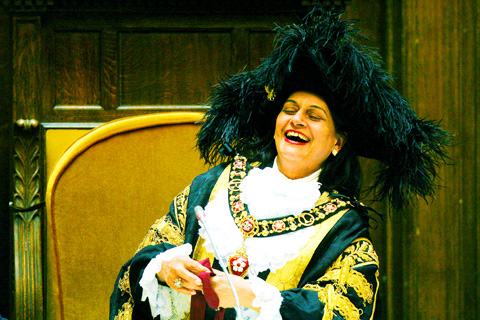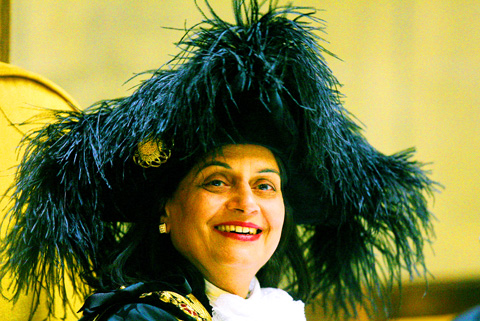Manjula Sood made history this week when she slipped the gilded robes and chain of office over her sari and became lord mayor of the British city of Leicester.
A south Asian woman has never held the largely ceremonial post in the 799 years since it was created in the city nor in the 1,000 years or so that it has been in existence elsewhere in Britain.
It is a first not just for Sood, 12 years after following her late husband, Paul, into local politics, and just over 38 years after she arrived in the English East Midlands from the Punjab on a cold, dark snowy winter’s day.

PHOTO: AFP
It is also the latest sign of the transformation of Leicester, famous for its textile, footwear and hosiery industry, as it moves towards becoming the UK’s first non-white majority city in the not too distant future.
“To be the first is a great honor for me,” the Indian-born former primary schoolteacher said of the 12-month post, which began on Thursday.
“It’s made me very proud of myself that I’m going to represent my city ... . I wasn’t expecting it.”

PHOTO: AFP
The appointment to lead Leicester’s 288,000 or so citizens, 25 percent of whom are of Indian origin, puts Sood among the UK’s establishment, although she has held the ancient post of High Bailiff of Leicester for the past year.
On a wider scale, it also says much about the positive aspects of immigration that are often overlooked here by the debate over the extent to which new arrivals benefit the UK and affect its culture and identity.
At a glance, Sood seems the embodiment of the successfully integrated immigrant championed by modern-day politicians, many of whom she says have been fed at her kitchen table and passed through while campaigning locally.
It is not just the immaculate black sari set off by the shiny Blackberry personal organizer, the comfortable semi-detached house in a residential suburb or the fact that she has taken UK citizenship and speaks fluent English.
There are photographs of her two grownup sons, in gowns and mortar boards, proudly clutching degree scrolls from British universities: one is also a municipal councilor in Leicester; the other works for an investment bank.
A framed woman of achievement and a national merit award from the governing Labour Party are hung on another wall.
On a corner table by the coal-effect gas fire is a photograph of Hindu guru Sathya Sai Baba next to medieval-style Christian religious icons and rosary beads.
An Anglican canon is a close friend; she sits on the Leicester Council of Faiths and social, health and women’s groups; two African Caribbean men have the keys to her house to do odd jobs, she says.
Sood says she feels a duty over the next 12 months to uphold Leicester’s largely harmonious diversity at a time when critics of multi-culturalism warn of no-go areas for non-whites and communities living parallel lives elsewhere.
“I’m going to be the lord mayor not for one faith but for the city of Leicester,” she said.
One of her spiritual advisers will be Christian. The other will be Hindu. The civic service to mark her appointment will also be held in the city’s Anglican cathedral rather than a Hindu temple.
“Leicester’s a British city,” she says. “I’m representing Leicester as first citizen. The religion of this country is Church of England.”
Sood, though, recognizes that her story is not typical of the vast majority of immigrants that came to the UK and that she was fortunate.
She spoke the language, held a master’s degree in sociology and came from a well-off family: her father was a doctor in New Delhi, her mother a teacher.
An assertive nature helped when she went into teaching after being told to settle for factory work like many newly arrived Indian women — or stay at home in often substandard accommodation.
But she said she still faced the same challenges of casual racism, ignorance and prejudice as the thousands of other Indians, Pakistanis, Bangladeshis, and Kenyans and Ugandans of South Asian ancestry who made their way to Leicester in the 1970s.
As the only Indian teacher among white faces she said she pushed to promote tolerance and understanding between often bewildered newly arrived children of different faiths and cultures and their local classmates. The UK is now a more tolerant place than the one she knew in 1970, she says, with people more respectful of diversity of culture and faith.
But work is still required as a new wave of immigrants, many of them from Eastern Europe, arrive in increasing numbers — and “outreach” is the aim of her term of office as lord mayor.
“The communities that came here in the 60s and 70s now feel an integrated part of British society. Now there are new communities finding the same problems,” she said.
“History is being repeated. The same challenges are facing them. There’s always some sort of hostility from the host community. It’s a human instinct but if we don’t work at it and don’t kill it, it will escalate.”

Nov. 11 to Nov. 17 People may call Taipei a “living hell for pedestrians,” but back in the 1960s and 1970s, citizens were even discouraged from crossing major roads on foot. And there weren’t crosswalks or pedestrian signals at busy intersections. A 1978 editorial in the China Times (中國時報) reflected the government’s car-centric attitude: “Pedestrians too often risk their lives to compete with vehicles over road use instead of using an overpass. If they get hit by a car, who can they blame?” Taipei’s car traffic was growing exponentially during the 1960s, and along with it the frequency of accidents. The policy

Hourglass-shaped sex toys casually glide along a conveyor belt through an airy new store in Tokyo, the latest attempt by Japanese manufacturer Tenga to sell adult products without the shame that is often attached. At first glance it’s not even obvious that the sleek, colorful products on display are Japan’s favorite sex toys for men, but the store has drawn a stream of couples and tourists since opening this year. “Its openness surprised me,” said customer Masafumi Kawasaki, 45, “and made me a bit embarrassed that I’d had a ‘naughty’ image” of the company. I might have thought this was some kind

What first caught my eye when I entered the 921 Earthquake Museum was a yellow band running at an angle across the floor toward a pile of exposed soil. This marks the line where, in the early morning hours of Sept. 21, 1999, a massive magnitude 7.3 earthquake raised the earth over two meters along one side of the Chelungpu Fault (車籠埔斷層). The museum’s first gallery, named after this fault, takes visitors on a journey along its length, from the spot right in front of them, where the uplift is visible in the exposed soil, all the way to the farthest

The room glows vibrant pink, the floor flooded with hundreds of tiny pink marbles. As I approach the two chairs and a plush baroque sofa of matching fuchsia, what at first appears to be a scene of domestic bliss reveals itself to be anything but as gnarled metal nails and sharp spikes protrude from the cushions. An eerie cutout of a woman recoils into the armrest. This mixed-media installation captures generations of female anguish in Yun Suknam’s native South Korea, reflecting her observations and lived experience of the subjugated and serviceable housewife. The marbles are the mother’s sweat and tears,